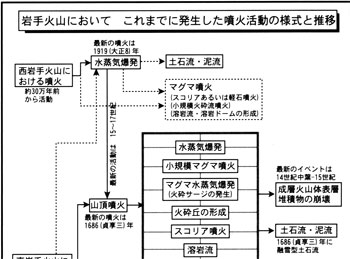Iwate Volcano
1: Introduction / 2: Geology of Iwate Volcano / 3: Outline of Iwate Volcano
4: Eruption history of Iwate Volcano
5: Eruptions of historical times / 6: Latest activities
7: Monitoring of volcanic activities / 8: Points to be watched for mitigation of disaster
Acknowledgment / References
![]() PREV
PREV ![]() NEXT
NEXT
7: Monitoring of volcanic activities / 8: Points to be watched for mitigation of disaster
7: Monitoring of volcanic activities
After the eruption of 1998, monitoring of volcanic activities by many institutions had been intensified. However, as the activities became less vigorous from 2003, reorganization of monitoring has been discussed.
Earthquakes and volcanic tremors have been monitored by Meteorological Agency, Tohoku University, and Iwate Prefecture. Crustal deformation using GPS has been monitored by Meteorological Agency, Geographical Survey Institute, Tohoku University, and AIST, while Geographical Survey Institute has been engaged in monitoring with electronic distance meter. Surveillance cameras have been employed by Meteorological Agency, and Iwate River and Road Office of Ministry of Land, Infrastructure and Transport. Other monitoring activities include concentrations of volcanic gasses ( SO2 and H2S ) at Oojigokudani by Tokyo Institute of Technology, and ground temperatures on ridges of Kurokurayama to Ubakurayama by Iwate Prefecture.
8: Points to be watched for mitigation of disaster
Modes of eruptions and their transitions from one to the other in Iwate Volcano are rich in varieties during its history spanning over hundreds of thousands of years, and consequently prediction of those is not easy ( ![]() Fig. 5 ). Among various possibilities, magmatic eruption in Higashi-Iwate Volcano and phreatic explosion in Nishi-Iwate Volcano are most likely. In Higashi-Iwate Volcano, Yakushi crater would be likely site, but formation of row of new craters on its flank is another possibility. Likely modes of eruptions include ejection of ash and lava, and formation of scoria cone, but the mode may change with time. Duration of eruption may be up to a few days, but continuing small-scale eruptions for a long time is another possibility.
Fig. 5 ). Among various possibilities, magmatic eruption in Higashi-Iwate Volcano and phreatic explosion in Nishi-Iwate Volcano are most likely. In Higashi-Iwate Volcano, Yakushi crater would be likely site, but formation of row of new craters on its flank is another possibility. Likely modes of eruptions include ejection of ash and lava, and formation of scoria cone, but the mode may change with time. Duration of eruption may be up to a few days, but continuing small-scale eruptions for a long time is another possibility.
Phreatomagmatic explosion and debris flow from mixing of magmatic material with melted snow are highly likely in winter. As type of disaster depends on the season, mitigation measures have to be considered against different types. The summit of Yakushidake is partly over the angle of repose and ejected ash and scoria cannot stay at the site of deposition and may collapse.
Phreatomagmatic explosion in Nishi - Iwate Volcano is considered to be small in scale but cinders may fall on the mountain track. If phreatomagmatic explosion is large in scale, ejected ash may reach eastern foot areas and debris flow may be triggered.
Also the possibilities of magmatic activities in Higashi - Iwate Volcano triggering phreatic explosion in Nishi-Iwate Volcano and its western areas, and intensifying thermal activities of fumaroles and increased seismic activities in the surrounding areas have to be watched.
